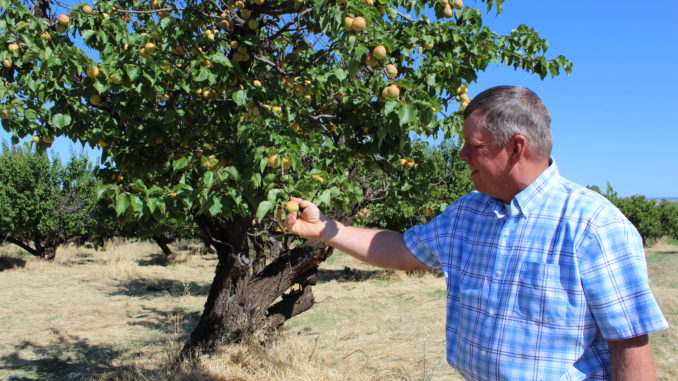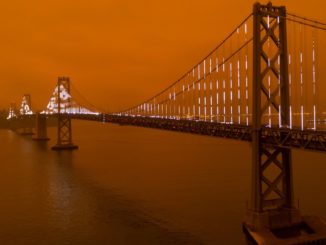
Business started booming for the Bamford family shortly after they opened the doors to their olive oil tasting room and gift shop in 2016. People constantly trickled into the downtown Oroville storefront to sample the award-winning oil from their more than century-old orchards and purchase beef from their pasture-raised cattle.
That’s why it was such a shock to customers when the Butte Valley-based business closed up shop this past December, co-owner Joey Bamford told the CN&R.
Bamford Family Farms shut its doors one year and one month after the November 2018 Camp Fire. The blaze destroyed the upper portion of the Miocene Canal, the water source that nourished the family’s orchards and the pastures that fed their cattle. Since then, thousands of acres have dried up, damaging family-owned and operated farms and ranches throughout the region. Some are barely eking by in the now-parched landscape, surviving by tearing out trees and selling cattle.
“[Business] had really taken off,” Bamford said, “and then, when we lost the water, everything else was lost.”
On March 23, the Bamfords got good news. Butte County District Attorney Mike Ramsey and PG&E—the owner of the upper and middle portions of the canal—sent out press releases stating that the utility company had pledged to restore water access to those impacted.
The agreement is just one part of PG&E’s response to an indictment by a Butte County Grand Jury following a criminal investigation by Ramsey’s office into the utility’s role in the devastating blaze. The company later this month will plead guilty to 85 felonies, including 84 counts of involuntary manslaughter, and pay the maximum fine of approximately $3.5 million plus $500,000 for the cost of the investigation.
Despite this apparent win for Miocene-reliant residents, however, a permanent solution hasn’t been identified. Meanwhile, another dry season approaches, threatening to cripple agricultural operations in the region.
A long investigation
For more than 100 years, the 25-mile-long Miocene Canal sustained the lush valley where Bamford Family Farms and other farms and ranches flourished. Created during the Gold Rush, the man-made system of earthen ditches and wood-supported metal flumes also sustained a thriving ecosystem and helped protect the area from wildfires.
Before the upper portion burned in the fire, the canal spanned from Magalia to Oroville.
The Bamfords joined more than a dozen other canal users with water contracts—many so old they are written in “miner’s inches”—to find a way to restore water conveyance. Dubbed the Miocene Canal Coalition, the group met repeatedly with other stakeholders, Butte County staff and PG&E representatives—but the latter’s officials eventually stopped attending the meetings.
“It felt like and appeared like no one was willing to help us,” Bamford said. “We had gone to every single avenue we could think of and we just kept hitting brick walls.”
Indeed, the coalition reached out to Ramsey’s office many times in the past year, urging the county’s top lawman to force PG&E to take action, the DA told the CN&R.
“Quite frankly, I kind of kept them at arm’s length because I knew in the back room this was being discussed and would hopefully resolve those issues,” he said.
Ramsey said his office first started pressing the utility about the Miocene Canal in June 2019, when PG&E President and CEO Bill Johnson and the company’s board members made a court-ordered visit to Paradise. During negotiations in the months that followed, his office continued to bring up the topic.
“Off and on through the various discussions of PG&E’s desire to settle the criminal matter, [my office] had told them, ‘Don’t forget about the Miocene Canal,’” Ramsey said.
He added that the issue strikes a chord personally. His father was a local game warden who worked in the region.
“As a kid, I ran around with him on that canal,” Ramsey said.
Ed Cox, a Butte Valley resident and spokesman for the coalition, told the CN&R that those dependent on the Miocene are ready to sit down and talk about how to move forward—as they have been doing for the past year, when they first made their case before the Butte County Board of Supervisors.
“We’re excited about the next steps,” Cox said. “Instead of fighting to get something done, now we’re going to advocate, I hope, in how it gets done and some timelines so we don’t suffer another brutal summer.”
There are still a lot of unanswered questions, however. PG&E has yet to make a plea in Butte County Superior Court. Its original court date, set for last Friday (March 27), was delayed until April 24 due to the COVID-19 pandemic. The agreement also must be approved by the bankruptcy court.
Details released thus far indicate that PG&E has pledged up to $15 million over the next five years toward the cost to restore water access to those impacted, according to PG&E spokesman Paul Moreno. He was unable to elaborate on the specifics, such as whether the upper portion of the canal would be repaired.
“PG&E plans to begin discussions with the county about implementation planning as soon as possible and consistent with current public health orders limiting public meetings and gatherings,” he wrote in an email to the CN&R.
Ramsey noted that the option discussed most in negotiations is putting a pipe into Lake Oroville—where water that would typically flow down the Miocene is currently being diverted—and pumping water to the intact Middle Miocene. However, “everything is on the table,” Ramsey said.
Water worries continue
Last July, PG&E began delivering up to 5,000 gallons of water per household per week to help households get through the dry summer months. Moreno told the CN&R that the company will continue that effort.
It’s a service that has helped ranchers meet some of their cattle’s water needs, but it’s nowhere near enough to sustain the irrigation demands of orchardists.
That’s what Kurt Albrecht experienced. His family, third-generation owners of Chaffin Family Orchards, tore out 15 acres of dying peach and apricot trees last year. They have had to tap into savings and use their private reservoir to keep operating. And that, Albrecht added, was during a year with a decent rainy season that created a good soil moisture content.
If his family is forced to endure another summer without ample water, Albrecht will have to rip out another 5 acres of orchards. And across the valley, he predicts additional downsizing and further agricultural and economic losses.
“These people that have been dependent on water for tree production are going to have to gear more towards livestock, cause that’s all the land’s going to be good for,” he said. If that happens, his family won’t be able to employ as many people, he added.
Without the canal, though, Bamford said the land isn’t even ideal for grazing. Ranchers already have had to budget for additional hay costs due to the lack of irrigation and thus grasses, she noted. Some of her neighbors have had to purchase additional water or sell cattle to get by.
As she sees it, restoring the canal is the only viable path forward.
“[The Miocene] was responsible for filling the ponds, the creeks, the wetlands, the wells—it goes on and on how much that canal did for us and everyone,” Bamford said. “In our mind, for them to fix that canal is the only option, period.”




Most of the public support regarding the Middle Miocene Canal stems from the erroneous view that the canal is a public hiking system. This is certainly not the case, especially of the Middle Miocene. These canals are owned by the landowners, not PG&E, not the state. PG&E has an easement to maintain the canal, just like they can maintain the electricity to your home.
The construction of the Middle Miocene Canal itself is a marvel of stupidity. The lower half is the only portion that is covered in a water proof substance. The upper half is just dirt, which allows the seepage that the Miocene Canal Coalition is wanting. What they do not tell you is that this adds to the fire danger by allowing vegetation to grow that would not naturally be there.
PG&E is not a good steward of the land the Middle Miocene flows through. There are pictures of a PG&E employee stealing wood from private land which has not been responded to by PG&E. Early this year, PG&E sent a team through the Middle Miocene area, cutting trees and leaving gates open to trespassers and the escape of livestock. After the cutting of the trees, the branches were piled and left, adding to the fire danger of the area. The supervisor of this area does not bother to return phone calls of the landowners.
The strain of the local ranchers, olive growers and residents stems from the Camp Fire and the loss of water and the loss of customers due to the fire. However, wise investments on the part of the owners could go a long way to make life easier. There are grants available for wells. These people are pushing to have life return to normal as it was before the fire. Listen up people. This is the new normal. An entire region has been devastated. Your customer base is gone. The Feather River will recharge your wells. Stop pretending that it isn’t there.
The plight of approximately 12, yes 12, contracted water users is, I’m sure, real. But seriously, $15 million to repair a leaking canal for the benefit of 12 customers WHO LOST NOTHING ELSE in the fire? That’s over $1 million per contracted user. Did the residents of Paradise, Concow and Magalia get $1 million each when they lost everything?
Let PG&E drill wells for the 12 customers. Let’s use the remaining funds to rebuild the community.
What I’m reading from the prior comment is that clearly this person doesn’t understand the purposes of the Canal nor correct information. PG&E does indeed own the Upper and Middle portions of the Canal as the article states, and they have owned it for well over one hundred years! They are at fault and responsible for its repair. The Lower part has been owned by CalWater for several years. What you read in the newspaper months ago was a lie by omission on PG&E behalf when they stated that there are only 12 water customers!! What they failed to say, is that those 12 customers pay for additional miners inches to be allowed to be released via gates to irrigate. They also failed to mention that the Canal provided water to every water source from the seepage of the Canal! This seepage that flowed in to the environment was well over 5,000 acre ft. per year. This water fed creeks that spread from ranches and farms from Hwy .70 to Hwy. 99. From Table Mountains hillsides all the way around to Oroville Forebay Channel, the wetlands at Wick’s Corner and up 70 to 99 and all land in between! It created vast ecosystems providing for endangered species of plants, trees, and animals of all varieties along with the native varieties. It provided hundreds of farms, ranches, and personal home wells to be filled along with ponds, reservoirs, and creeks that were not only used by farmers to fight fires but CalFire as well! It also supplied the groundwater. You also cannot sell property with homes on them that do not have water! Our property values have plummeted. It goes way beyond 12 customers!!! This valley sits on a lava cap making it near impossible to drill for near non existent water in some places. No, we didn’t lose our homes to fire in 18 as horrifically so many did. We, however still could very easily with no water to fight it with to be found. Homesteads ARE being lost to lack of water. Lifetimes, some generational, are losing everything, if not already. The impact and damage of not having the Canal goes much farther than what meets the eye!!!
I urge everyone to check out our Facebook page where you’ll find much more detailed information regarding the Canal than what could be printed in an excellent article!! You can find that page under Miocene Canal Coalition.